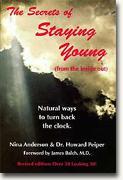The Secrets of Staying Young, from the Inside Out
Nina Anderson & Howard Peiper
book reviews:
· general fiction
· chick lit/romance
· sci-fi/fantasy
· graphic novels
· nonfiction
· audio books
· author interviews
· children's books @
curledupkids.com
· DVD reviews @
curledupdvd.com
newsletter
win books
buy online
links
home
for authors
& publishers
for reviewers

 |
Over 50 Looking 30, The Secrets of Staying Young (from the inside out) Nina Anderson & Dr. Howard Peiper Safe Goods Paperback 176 pages February 1999 |
|
According to the authors, Secrets of Staying Young (from the inside out), the revised edition of Over 50 Looking 30, is for those who think they're too old to change. The book tries to answer a pragmatic question rampant in our society: "Are you confused about the road to take for better health?" Authors Nina Anderson and Dr. Howard Peiper introduce the basics of food, nutrition, and possible longevity, starting from the table to the body's cells -- that is, what goes into the body. One recommendation made for proper eating and supplement utilization: check to assure the stomach stays slightly alkaline with a urine Ph level above 6.2. The authors discuss how far and how many ways the colon can be cleansed through various fasting and purging regimes with foods, teas, herbs, and supplements.
A discussion of trace minerals, enzymes, and essential fatty acids broadens into speculation on the respective roles of garlic, bioflavonoids, and various other plants and chemical substances. The authors suggest these materials function synergistically within the body to combat aging while stimulating vitality and positive growth processes. These chemical functions may play a large, small, or no significant role in the prevention and reduction of symptoms in chronic diseases like hypertension, heart and circulatory conditions, eye disorders, hormonal imbalances, post-menopausal symptoms (e.g., "hot flashes"), impotence, panic attacks, pain, insomnia, depression, diabetes, Parkinson's, and arthritis to varicose veins, and a growing list of stressful, burdensome maladies. The discussion of how fats are formed and may be deposited in the circulatory system through plaque formation and attachment, and some pros and cons regarding the national debate over the use of estrogen and hormonal supplements in women, and men, are two informative parts of the book. However, the absolute health and nutritional prescription against the use of excitotoxins like aspartame is presented without any qualification or exception. When discussing grasses and leafy green vegetables, the authors insert a paragraph about an old scientist's search for an electrolyte formula based on his perception that grasses contained a unique, electrical magnetic energy. The authors' conclude that "The relatively high level of the electrical energy force, transferred from the earth's magnetic field is sent via these same live grasses." (pp. 66-67) Later, the authors appear to say that depression, like other emotional problems, can be learned, and is not just a reaction to physical disease processes. For a much earlier point-of-view, readers may want to see the works of Sigmund Freud. We know that in each of us there can be self-fulfilling beliefs, aspirations, and goals which function together over time to shape, direct, and interpret behavioral consequences in positive, esteem-building, socially-approved ways or in negative, persistent, habitual, self-defeating ways. The use of visual imagery to help people heal themselves is not a new concept or treatment, irrespective of the constructs used (e.g., imagine Disney cartoons in "good tourist" roles and "bad terrorist" roles) to reduce allergic reactions. Readers are left to wonder if some of these methods and strong, unequivocal conclusions are The Secrets of Staying Young and living longer, like the title and introduction suggest, or just hype and product promotion? The Appendix offers a two-page disclaimer on the nutrient values of foods and supplements, but asks us to discriminate between ones which may, or may not, help with a specific illness, disease, health condition, wellness or fitness goal. Doesn't it seem reasonable that a book on nutrition, multiple supplements, herbs, and plants would help us choose between them, reduce confusion, and offer a set of criteria for decision-making? Forty-one businesses listed in the Resource Directory sell many, if not all, the supplements referenced in the book and apparently have supported in some material ways to the authors' research and publishing activities.
|
|
|
|
 Click here to learn more about this month's sponsor! |
|
| fiction · sf/f · comic books · nonfiction · audio newsletter · free book contest · buy books online review index · links · · authors & publishers reviewers |
|
| site by ELBO Computing Resources, Inc. | |
 The authors briefly highlight some essentials about minerals, enzymes, fatty acids,
green, "live" foods, natural treatments, and homeopathic medicines that may contribute
to our body's "internal pharmacy" and probable longevity. One of the side effects of
detoxifying the body can be emotional instability. The authors make the astonishing
claim that when "toxins are released [from the body], they may have memories attached
to them that have been stored in the cells..." (p. 29) which can contribute to expressions
of grief, fear, and anger.
The authors briefly highlight some essentials about minerals, enzymes, fatty acids,
green, "live" foods, natural treatments, and homeopathic medicines that may contribute
to our body's "internal pharmacy" and probable longevity. One of the side effects of
detoxifying the body can be emotional instability. The authors make the astonishing
claim that when "toxins are released [from the body], they may have memories attached
to them that have been stored in the cells..." (p. 29) which can contribute to expressions
of grief, fear, and anger.